Male gymnasts have always competed on floor, pommel horse, rings, vault, parallel bars, and high bar, right?
Wrong.
Male gymnasts had quite the journey to today’s competitive format. Here’s a look at events in which the men competed in the early years of the Olympic Games and World Championships.
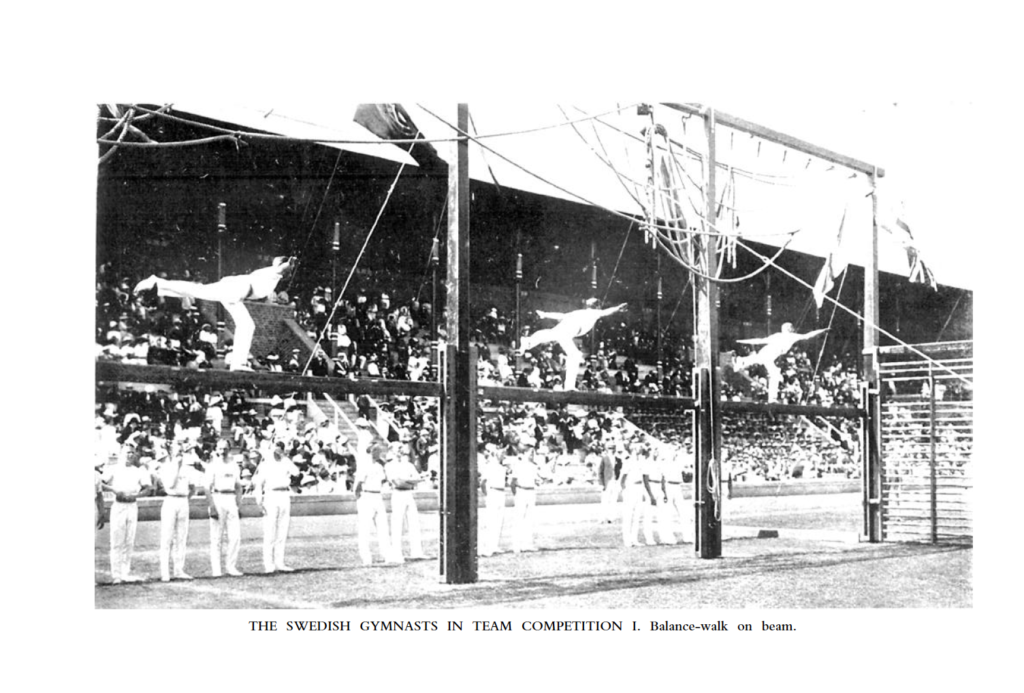
Quick Links: General Observations | Cheat Sheet
1896 Olympics | 1900 Olympics | 1903 World Championships | 1904 Olympics | 1905 World Championships | 1907 World Championships | 1908 Olympics | 1909 World Championships | 1911 World Championships | 1912 Olympics | 1913 World Championships | 1920 Olympics | 1922 World Championships | 1924 Olympics | 1926 World Championships | 1928 Olympics | 1930 World Championships | 1932 Olympics | 1934 World Championships | 1936 Olympics | 1938 World Championships | 1948 Olympics | 1950 World Championships
Appendix: Context about Track and Field Events at Gymnastics Competitions
Note #1: The World Championships were originally called “International Tournaments.” The FIG retroactively renamed them. I will use the two terms interchangeably in this post.
Note #2: You may want to brush up on the different types of boards used over the years.
Note #3: You can find the women’s gymnastics version of this post over here.
A Few General Observations
1896 Olympics: Since 1896, male gymnasts have always competed on parallel bars and high bar.
1908 Olympics: Gymnasts competed on both swinging and still rings at the Olympics.
1909 International Tournament (World Championships): This is the only time that the men didn’t compete on pommel horse at a major event.
1912 and 1920 Olympics: The gymnasts could compete on balance beam.
1920 Olympics: The men competed on an obstacle course during the team competition. It was judged for aesthetics.
1920 Olympics: The first time floor exercise is competed individually at the World Championship or Olympic Games. (It was likely calisthenics.)
1922 and 1926 International Tournaments: The men competed in a 50 m freestyle swim. (As you can imagine, a few gymnasts didn’t know how to swim.)
1926 International Tournament: The last time that a men’s team performed on the flying rings at the World Championships or Olympic Games.
1928 Olympics: The last time the men competed an ensemble routine at the World Championship or Olympic Games.
1930 International Tournament: The first time individual compulsory floor is performed.
1936 Olympics: The first time that the men competed on the six apparatus (i.e. floor, pommel horse, rings, vault, parallel bars, and high bar) without any additional athletics events or ensemble routines.
1950 World Championships: The last time that gymnasts competed in track and field events at a major international competition.
Cheat Sheet
If you’re looking for a quick reference guide, you’re in luck. You can download the PDF below. But if you’re looking for more detail, keep scrolling for more info on the individual competitions.
Note: If you’re looking for the equivalent for women’s gymnastics, head over to this post.
1896 Olympics (Athens)
Ensemble:
- Parallel Bars
- High Bar
Optional Routines:
- Pommel Horse
- Rings
- Long-Horse Vault
- Parallel Bars
- High Bar
Other:
- Rope climb
More on the 1896 Olympics: 1896: Gymnastics at the Olympic Games
1900 Olympics (Paris)
The 1900 Olympic Games were held in conjunction with the World’s Fair.
For gymnastics, there were three events: the French Federal Festival of Gymnastics, the International Championships (July 29 and 30), and the competition of the Gymnastics Societies of the Seine. The notes below are for the International Championships.
Ensemble Routines:
- Compulsory Floor Exercise (without portable hand devices)
- Optional Floor Exercise (without portable hand devices)
Compulsory Routines:
- Pommel Horse
- Rings
- Parallel Bars
- High Bar
Note: There wasn’t a compulsory vault.
Optional Routines:
- Pommel Horse
- Rings
- Long Horse Vault
- Parallel Bars
- High Bar
Track and Field:
- Combined long and high jump*
- Long jump
- Pole Vault
Other:
- Rope Climb
- Lifting of a 50 kg Rock 10x
*You can see an image of the combined long and high jump in this book on German-American gymnastics from 1896. It was sometimes called the highfar jump or the high long jump in English.
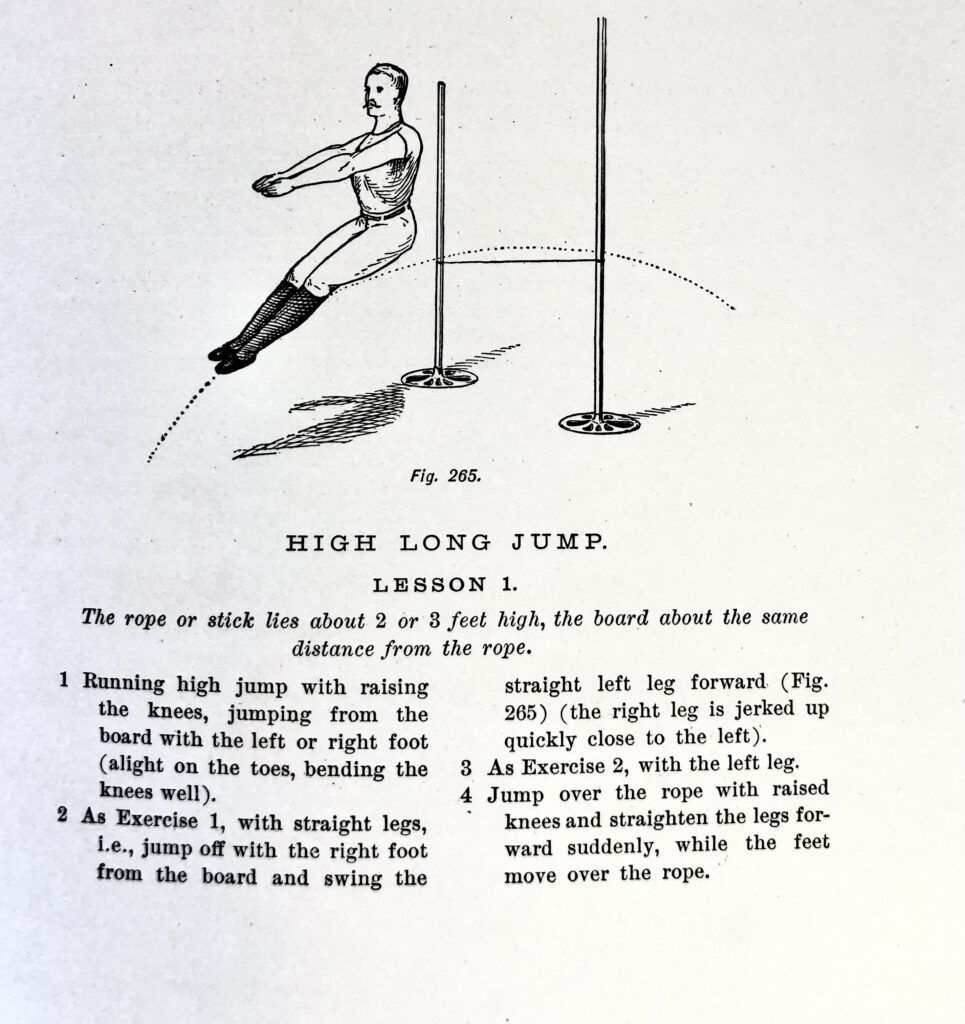
1903 – The First International Tournament (Antwerp)
Ensemble Routines:
- 6 Compulsory Floor Routines (without Portable Hand Devices)
Note: At the World Championships, all of these exercises were performed simultaneously but scored individually. They weren’t like floor exercise routines today. Rather, think of them as calisthenics exercises.
Compulsory Routines:
- Pommel Horse
- Rings (2 Sets of Compulsory Ring Routines)
- Parallel Bars (2 Sets of Compulsory Parallel Bar Routines)
- Horizontal Bar (2 Sets of Compulsory High Bar Routines)
- Long Horse Vault
Optional Routines:
- Pommel Horse
- Rings
- Parallel Bars
- High Bar
Track and Field:
- 150 m
- High jump
Other:
- Lifting a 40 kg weight 20x
More: 1903: Men’s Gymnastics at the First World Championships
1904 – Olympics (St. Louis)
The 1904 Olympic Games were held in conjunction with the World’s Fair. This was the calendar of events for gymnastics:
- June 18: mass exhibition
- July 1 and 2: International competition for teams and individuals
- August 18: YMCA championships
- October 27: mass exhibition
- October 28 and 29: AAU championships.
The events listed below are from the competition on July 1 and 2.
Compulsory Routines:
- Pommel Horse
- Long Horse Vault
- Parallel Bars (2 Sets of Compulsory Parallel Bar Routines)
- High Bar (2 Sets of Compulsory High Bar Routines)
Optional Routines:
- Pommel Horse
- Parallel Bars
- High Bar
Track and Field:
- 100 yards (91.44 m)
- Shot put (7.257 kg)
- Long jump
1905 – Second International Tournament (Bordeaux)
Ensemble:
- 5 Sets of Compulsory Floor Routines (without Portable Hand Devices)
Note: At the World Championships, all of these exercises were performed simultaneously but scored individually. They weren’t like floor exercise routines today. Rather, think of them as calisthenics exercises.
Compulsory Routines:
- Pommel Horse
- Long Horse Vault
- Parallel Bars (2 sets of compulsory routines)
- Horizontal Bar (2 sets of compulsory routines)
Optional Routines:
- Pommel Horse
- Parallel Bars
- Horizontal Bar
Track and field:
- 150 m sprint
- Long jump
- Stone throw with each arm (15 kg)
More: 1905: The World Championships That Almost Didn’t Happen
1907: The Third International Tournament (Prague)
Ensemble:
- 5 Sets of Compulsory Floor Routines (without Portable Hand Devices)
Note: At the World Championships, all of these exercises were performed simultaneously but scored individually. They weren’t like floor exercise routines today. Rather, think of them as calisthenics exercises.
Compulsory Routines:
- Long Horse Vault
- Parallel Bars
- Horizontal Bar
Optional Routines:
- Pommel Horse
- Parallel Bars
- Horizontal Bar
Track and Field:
- 150 m
- Combined high and long jump*
Other:
- Lifting of a 35 kg weight, maximum of 20 times
*From the rules: Rope at a constant height of 1.10m. The jump is taken on a hard board (tremplin dur) located 2 m from the rope. The board is moved by 5 cm to a maximum of 3.60 m which gives 20 points. Two tries at each distance.
See the 1900 Paris Olympics for an illustration of the combined high and long jump.
More on 1907:
- 1907: The Rules for the World Championships in Prague
- 1907: Perfect Scores Abound at the World Championships in Prague
1908: Olympics (London)
Team Competition
Ensemble Routines:
- “Group exercises, which may include floor exercises and apparatus exercises, in all possible combinations.”
- Maximum time: 30 minutes
- Minimum: 16 gymnasts
- Maximum: 40 gymnasts
Individual Competition
Optional Routines:
- Pommel Horse
- Still Rings
- Swinging Rings
- Parallel Bars
- Horizontal Bar (2 Optional Routines — One Swinging Movements, One with Slow/Strength Movements)
Other:
- Rope climb
1909: Fourth International Tournament (Luxembourg)
Ensemble:
- 5 Sets of Compulsory Floor Routines (without Portable Hand Devices)
Note: At the World Championships, all of these exercises were performed simultaneously but scored individually. They weren’t like floor exercise routines today. Rather, think of them as calisthenics exercises.
Compulsory Routines:
- Rings
- Parallel Bars
- Horizontal Bar
Optional Routines:
- Rings
- Parallel Bars
- Horizontal Bar
Track and Field:
- 100m
- Combined long and high jump*
Other:
- Rope climb
*From the rules: The hard board (tremplin dur) is placed at a constant distance of 2 m from three elastic cords placed at 0.80 m, 1 m, and 1.10 m from the floor. The gymnast has to jump without touching the cords. Loss of 5, 10, or 15 points by touching respectively the third, the second, or the first. 15 points are awarded when passing without touching the ropes.
See the 1900 Paris Olympics for an illustration of the combined high and long jump.
For more on the 1909 World Championships, see this post: 1909: French Algerian Gymnasts Dominate the World Championships
1911: Fifth International Tournament (Turin)
Ensemble Routines:
- 3 Compulsory Floor Routines (without Portable Hand Devices)
Note: At the World Championships, all of these exercises were performed simultaneously but scored individually. They weren’t like floor exercise routines today. Rather, think of them as calisthenics exercises.
Compulsory Routines:
- Pommel Horse
- Rings
- Parallel Bars
- High Bar
Optional Routines:
- Pommel Horse
- Rings
- Parallel Bars
- High Bar
Track and Field:
- 100 m
- Pole Vault
- Shot put (7.257 kg) with each arm
Other:
- Rope climb
For more on the 1911 World Championships, you can check out this post: 1911: Competing in the Dark at the World Championships in Turin
1912: Olympics (Stockholm)
Team Competition
Competition I: Swedish System (Concours d’équipes comprenant des exercices selon le système suédois)
Between 16 and 40 competitors.
The time allowed to each team for the march in, the execution of various exercises and the march out, is 1 hour.
The following apparatus on the Swedish model will be placed at the disposal of the competitors:
- 4 beams (double);
- 20 ribbstalls (stall-bars), available from both sides, thus enabling 40 competitors to perform simultaneously ;
- 2 inclined ropes;
- 24 vertical ropes;
- 2 horses with adjustable legs;
- 3 plinths (vaulting-boxes);
- 1 buck with adjustable legs;
- 6 benches with balance-bar and movable hooks;
- 8 beam-saddles
Planks for the run and take-off will be at hand, and may be used if desired. Platforms and spring-boards may not be used.
Each competing team may arrange its own programme as regards the various movements.
Competition II: Special Competition (Concours d’équipes suivant des dispositions spéciales)
Between 16 and 40 competitors.
The time allowed to each team for the march in, the execution of various exercises and the march out, is 1 hour.
The competing teams shall execute:
a) a series of free exercises in unison, with or without hand apparatus (such as wands, sticks, dumbbells, clubs, etc.),
b) a series of exercises on the horizontal bar,
c ) “” parallel bars,
d) “” pommelled horse,
e) exercises according to the leader’s selection, with or without apparatus, but not with those mentioned under b, c, d, however.
All the competitors of a team shall perform the same series and must execute all the exercises.
Movements on one apparatus shall be completed by the entire team before movements on another apparatus are begun.
The order stated in the programme for the divisions a—e must be followed.
Apparatus.
The following apparatus will be placed at the disposal of the competitors:
4 Horizontal Bars.
(Height of bar 240 cm., length 220 cm., thickness 32 mm.; bar of polished steel.)
4 Parallel Bars.
(Parallel bars: height 160 cm., length of bars 3 m., their thickness 45—48 mm., and their distance from each other 42—45 cm.)
4 Pommelled Horses.
(Height of horse 130 cm., length 2 m., height of pommels 12—15 cm., distance from each other, 40—45 cm. and their thickness 31—33 mm.)
4 Pairs of Rings.
(Round rings, height 240 cm.)
Hand apparatus (such as wands, sticks, dumb-bells, clubs, etc.). Other movable apparatus, not mentioned here, must be supplied by the team.
Сompetition III: Competition with a choice of movements and apparatus (Concours d’équipes avec choix libre des exercises et des engins.)
Between 16 and 40 competitors.
The time allowed to each team for the march in, the execution of various exercises and the march out, is 1 hour.
The competing team shall itself select the movements.
Individual Competition
Optional Routines:
- Pommel Horse
- Rings
- Parallel Bars
- High Bar
1913: 6th International Tournament (Paris)
Ensemble Routines:
- 3 Compulsory Routines (without Portable Hand Apparatus)
Note: At the World Championships, all of these exercises were performed simultaneously but scored individually. They weren’t like floor exercise routines today. Rather, think of them as calisthenics exercises.
Compulsory Routines:
- Pommel Horse
- Rings
- Parallel Bars
- High Bar
Optional Routines:
- Pommel Horse
- Rings
- Parallel Bars
- High Bar
Track and Field:
- 100m
- Long jump with a tremplin dur
Other:
- Lifting a 40kg dumbbell 10x
- Rope climb
More on the 1913 World Championships: The Last World Championships before World War I
1920: Olympics (Antwerp)
Team Competition – Swedish System
16 to 24 gymnasts per nation. The following apparatus was available to the teams:
- 4 beams (double);
- 12 stall-bars (available from both sides, thus enabling 24 competitors to perform simultaneously);
- 2 inclined ropes;
- 12 vertical ropes;
- 4 horses with adjustable legs;
- 2 plinths;
- 2 bucks;
- 6 benches with balance-bar and movable hooks
Individual Competition
Maximum of 6 gymnasts per nation.
Compulsory Routines:
- Rings
- Parallel Bars
- High Bar
Optional Routines:
- Floor exercise
- Pommel Horse
- Rings
- Parallel Bars
- High Bar
Note: The rules didn’t use the term floor exercise. Rather, it said, “un exercice libre (sans engin ni instrument) au choix” — “a free exercise (without apparatus or instrument) as one chooses.”
Team Competition – European Gymnastics System
16 to 24 gymnasts per nation.
Ensemble Routine:
- Optional routine with or without portable hand devices – 10 to 15 minutes
Compulsory Routines (Performed Simultaneously):
- High Bar
- Parallel Bars
- Pommel Horse
Optional Routines (Performed Simultaneously):
- High Bar
- Parallel Bars
- Pommel Horse
Other
- Obstacle course judged for aesthetic beauty rather than time.
Note #1: In the European Federation System, the compulsory and optional routines on high bar, parallel bars, and pommel horse were performed simultaneously. So, all gymnasts performed the same optional routine.
Each apparatus was broken into four rounds, which meant, for example, that a team of 24 gymnasts had 6 gymnasts performing simultaneously per round.
Note #2: More on the obstacle course
Here is what this last test consists of:
In the obstacle course, the duration will not be taken into account, but the beauty of the race and the jumps as well as the simultaneity of the executions. The race cannot be restarted if a gymnast has touched or crossed the first obstacle.
Fifteen meters from the start, there is a first hurdle to cross; fifteen meters further on, there is a second hurdle; fifteen meters further, a third; fifteen meters further, the fourth; the course ends 15 meters after the fourth hurdle.
In the obstacle course, the duration will not be taken into account, but the beauty of the race and the jumps as well as the simultaneity of the executions. The race cannot be restarted if a gymnast has touched or crossed the first obstacle.
Une course d’obstacles: quatre haies de 0m70 de hauteur.
Voici en quoi consiste cette dernière épreuve:
A quinze mètres du départ, il y a une première haie à franchir; quinze mètres plus loin, se trouve une deuxième haie; quinze mètres plus loin, une troisième; quinze mètres plus loin, la quatrième; la course finit 15 mètres après la quatrième haie.
A la course d’obstacles, il ne sera pas tenu compte de la durée, mais de la beauté de la course et des sauts ainsi que de la simultanéité des exécutions. La course ne pourra être recommencée si un gymnaste a touché ou franchi le premier obstacle.
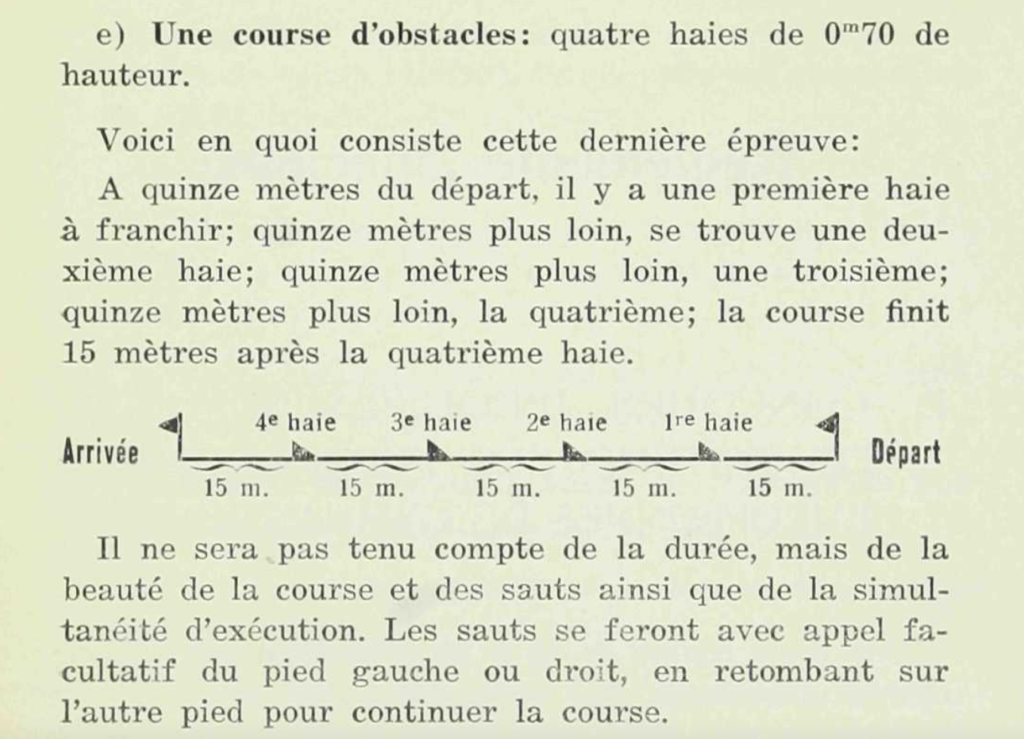
1922: 7th International Tournament (Ljubljana)
Ensemble Routines:
- 3 Compulsory Floor Routines (without Portable Hand Apparatus)
Note: At the World Championships, all of these exercises were performed simultaneously but scored individually. They weren’t like floor exercise routines today. Rather, think of them as calisthenics exercises.
Compulsory Routines:
- Pommel Horse
- Rings
- Parallel Bars
- High Bar
Optional Routines:
- Pommel Horse
- Rings
- Parallel Bars
- High Bar
Track and Field:
- 100 m
- High jump with a tremplin dur
- Shot put (7.257 kg), alternating arms.
Other:
- 50m freestyle swim
More here: The First World All-Around Champion in Men’s Gymnastics
1924: Olympics (Paris)
Compulsory Routines:
- Horizontal Bar
- Parallel Bars
- Rings
- Pommel Horse
- Combined High Jump and Long Horse Vault
- Side Horse Vault
Optional Routines:
- Horizontal bar
- Parallel Bars
- Rings
- Pommel Horse
Other:
- 8m rope climb
Note: The long horse vault was a combination of high jump and vault.
For more on the 1924 Olympics and the first perfect 10 in Olympic history, click here.
1926: 8th International Tournament (Lyon)
Ensemble Routines:
- 3 Compulsory Floor Routines (without Portable Hand Apparatus)
Note: At the World Championships, all of these exercises were performed simultaneously but scored individually. They weren’t like floor exercise routines today. Rather, think of them as calisthenics exercises.
Compulsory Routines:
- Pommel Horse
- Rings
- Parallel Bars
- High Bar
Optional Routines:
- Pommel Horse
- Rings*
- Parallel Bars
- High Bar
Track and Field:
- 100m
- High jump
- Shot put, alternating arms
Other:
- Rope climb 8m
- 50m freestyle swim
According to Raymond Burrell:
The Dutch perform their optional exercise in the form of flying rings. This will be the last time this type of work will appear in an international men’s competition.
Les étapes de la gymnastique au sol et aux agrès en France et dans le monde
Les hollandais exécutent leur exercice à volonté sous la forme d’anneaux balançants. Ce sera la dernière fois que ce type de travail apparaîtra dans une compétition internationale masculine.
To learn more about flying rings, click here.
More on 1926 here: The Men’s Competition at the World Championships in Lyon
1928: Olympics (Amsterdam)
Ensemble Routines:
- Optional routine without portable hand apparatus (10-12 minutes)
Compulsory Routines:
- Pommel Horse
- Rings
- Parallel Bars
- High Bar
Optional Routines:
- Pommel Horse
- Rings
- Parallel Bars
- High Bar
Vault Routines:
- A compulsory side horse vault with pommels
- An optional long horse vault without pommels
- Average of the two scores
More on the 1928 Olympics:
- 1928: The Rules for Men’s Gymnastics at the Olympic Games
- 1928: A Costly Math Error during the Men’s Competition at the Amsterdam Olympics
- 1928: The FIG’s Report on the Olympics in Amsterdam
1930: 9th International Tournament (Luxembourg)
Compulsory Routines:
- Floor exercise
- Pommel Horse
- Rings
- Parallel Bars
- High Bar
Optional Routines:
- Floor exercise
- Pommel Horse
- Rings
- Parallel Bars
- High Bar
Track and Field:
- 100m
- Long jump
- Pole vault
- Shot put, alternating arms
Other:
- Rope climb (8 m)
Note: The athletics events and rope climb were in the program but did not take place due to inclement weather.
More on the 1930 Worlds here:
- The Death of Anton Malej at the 1930 World Championships
- An Abrupt End to the 1930 World Championships in Luxembourg
1932 Olympics (Los Angeles)
Team Competition of 5 Gymnasts
Compulsory Routine:
- Pommel Horse
- Still Rings
- Parallel Bars
- High Bar
Optional Routine:
- Pommel Horse
- Still Rings
- Parallel Bars
- High Bar
- Floor Exercise – 2 to 3 minutes – But does not count toward the team or individual all-around total
Vaults:
- 2 compulsory vaults with the vault at 1.30 m and a tremplin dur of 10 cm
- 1 optional vault with the vault at 1.30 m and a tremplin dur of 10 cm
- 1 optional vault with the vault at 1.80 m and a tremplin à ressorts (springboard — but it didn’t have coiled springs)
Awards for this competition:
- Team all-around
- Individual all-around (based on the results acquired with each of the different apparatus and with the horse in length)
- Individual floor exercise
Individual Competition – 3 Gymnasts Maximum per Country
This was an individual competition in each discipline. Gymnasts had to perform two optional routines on their chosen apparatus.
Two Optional Routines:
- Pommel Horse
- Rings
- Vault
- Parallel Bars
- High Bar
Other:
- Rope Climb (8m)
- Club Swinging
- Tumbling
Awards for this portion of the competition:
- Pommel Horse
- Rings
- Vault
- Parallel Bars
- High Bar
- Rope Climb
- Club Swinging
- Tumbling
1934 World Championships (Budapest)
Compulsory Routines:
- Floor Exercise
- Pommel Horse
- Rings
- Long Horse Vault
- Parallel Bars
- High Bar
Optional Routines:
- Floor Exercise
- Pommel Horse
- Rings
- Long Horse Vault
- Parallel Bars
- High Bar
Track and Field:
- 100 m
- Pole vault
- Shot put, alternating arms
Note #1: According to the rules, there were no awards for floor exercise.
Note #2: At the meeting of the Men’s Technical Committee in 1935, they established a list of events that could be added to the program.
In the discussion on the regulations, the group of additional exercises used in competitions by F. I. G. was discussed. Rope climbing, which was referred to as suspended exercises, was removed from the group of additional exercises, and swimming was intended to be deleted. As a result, the group of additional exercises was established as follows: running long jump, high jump, pole vault, 7 1/4 kg shot put, swimming, and 100 m running. From this group, some exercises will be selected as additional exercises for gymnastic competitions. It has been established that only one-handed shot put is to be performed.
Dodatek Techniczny do Przewodnika Gimnastycznego “Sokół” 1935, Nr 10
W dyskusji nad regulaminem omówiono grupę ćwiczeń dodatkowych, stosowanych w zawodach F. I. G. Z grupy ćwiczeń dodatkowych usunięto wspinanie po linie, które określono jako ćwiczenia w zwieszeniu, oraz zamierzano skreślić pływanie. W rezultacie grupę ćwiczeń dodatkowych ustalono, jak następuje: z rozbiegu skok w dal, skok wwyż, skok o tyce, rzut kulą 7 1/4 kg., pływanie i bieg na 100 mtr. Z grupy tej wybierane będą niektóre ćwiczenia, jako dodatkowe, na zawody gimnastyczne. Ustalono, że rzuty kulą wykonuje się tylko jednorącz.
More on the 1934 World Championships:
- 1934: The Rules for the Men’s Competition at the World Championships
- 1934: Math Problems and Two Perfect 10s during the Men’s Competition at the World Championships
1936 Olympics (Berlin)
Compulsory Routines:
- Floor Exercise
- Pommel Horse
- Rings
- Long Horse Vault
- Parallel Bars
- High Bar
Optional Routines:
- Floor Exercise
- Pommel Horse
- Rings
- Long Horse Vault
- Parallel Bars
- High Bar
1938 World Championships (Prague)
Compulsory Routines:
- Floor Exercise
- Pommel Horse
- Rings
- Long Horse Vault
- Parallel Bars
- High Bar
Optional Routines:
- Floor Exercise
- Pommel Horse
- Rings
- Long Horse Vault
- Parallel Bars
- High Bar
Track and Field:
- 100 m
- High jump
- Shot put
More on the 1938 World Championships:
- 1938: The Official Rulebook of the World Championships
- 1938: Another Perfect 10 and Shot Put Struggles during the Men’s Competition at the World Championships
1948 Olympics (London)
Compulsory Routines:
- Floor Exercise
- Pommel Horse
- Rings
- Long Horse Vault
- Parallel Bars
- High Bar
Optional Routines:
- Floor Exercise
- Pommel Horse
- Rings
- Long Horse Vault
- Parallel Bars
- High Bar
More on 1948:
- 1948: The Men’s Rules and Apparatus Norms for the London Olympics
- 1948: The Men’s Gymnastics Competition at the London Olympics
1950 World Championships (Basel)
Compulsory Routines:
- Floor Exercise
- Pommel Horse
- Rings
- Long Horse Vault
- Parallel Bars
- High Bar
Optional Routines:
- Floor Exercise
- Pommel Horse
- Rings
- Long Horse Vault
- Parallel Bars
- High Bar
Track and Field:
- 100 m
- High jump
- Pole vault
More on 1950: 1950: A Perfect 10 in the Men’s Competition at the World Championships
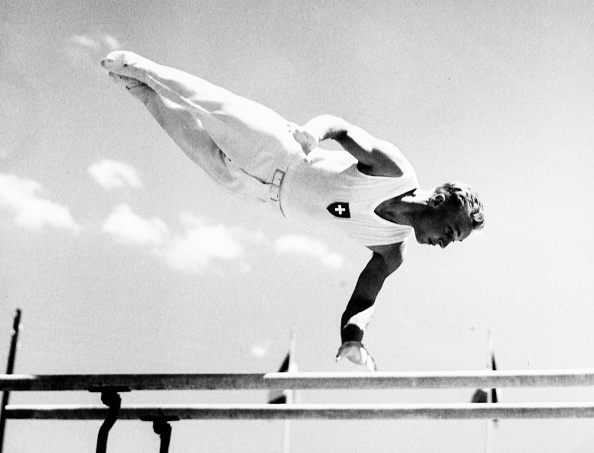
Sources: For the Olympic Games, I relied on the Official Reports and Rulebooks for the individual competitions.
For the World Championships, I relied largely on a series of articles in Olympische Turnkunst about the early World Championships.
Appendix: Track and Field Events
To modern fans, it seems strange that gymnasts competed in the high jump, pole vault, 100-meter sprint, among other events. But modern-day track and field events were part of many gymnastics traditions, particularly the German tradition.
Jahn, who is considered the father of gymnastics (der Turnvater) in Germany, wrote about track and field events in the first edition of his book Die Deutsche Turnkunst (German Gymnastics). For example, he wrote about the high jump:

And pole vaulting:
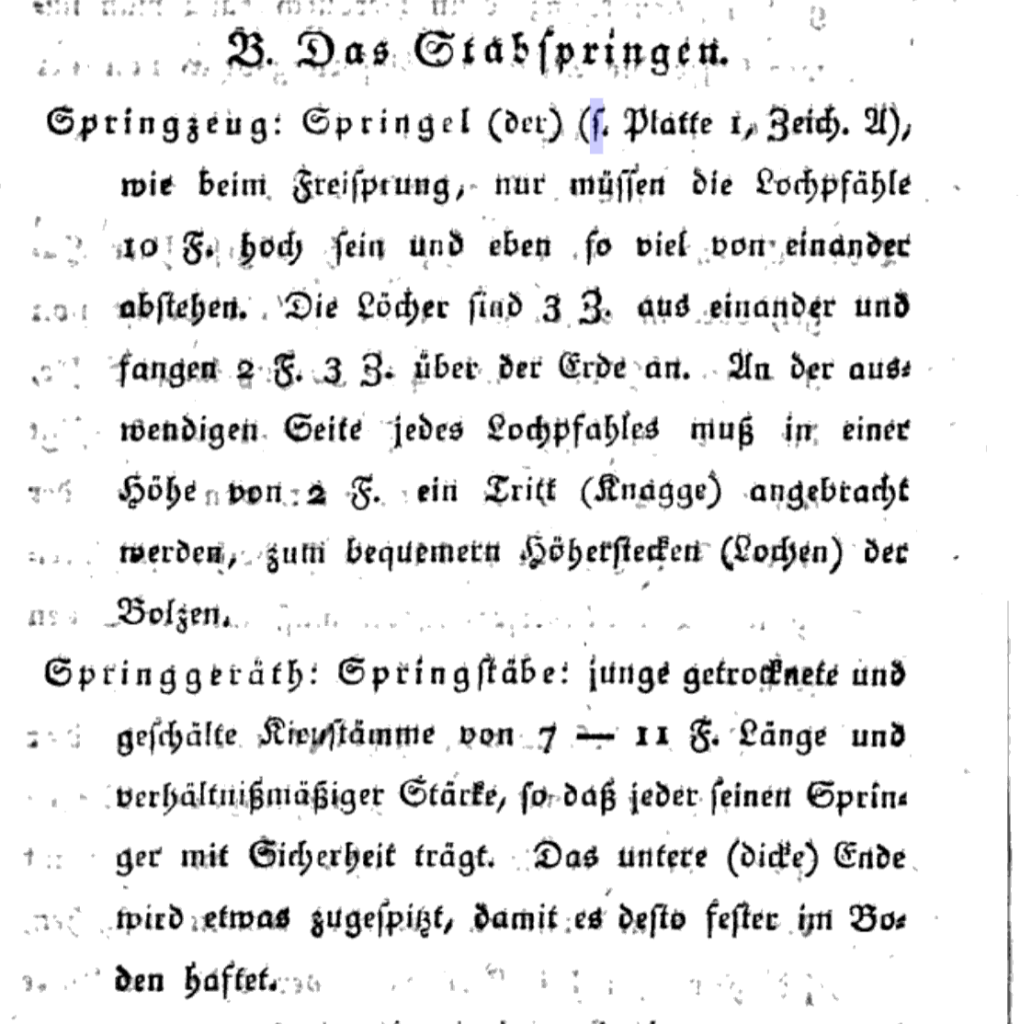
Note: In 1816, the pole was only 7’11” long. (Today, they are over 10 feet long.)
The German tradition held true to its roots in the United States. You can see, for example, that pole vaulting was part of the German-American system in 1896.
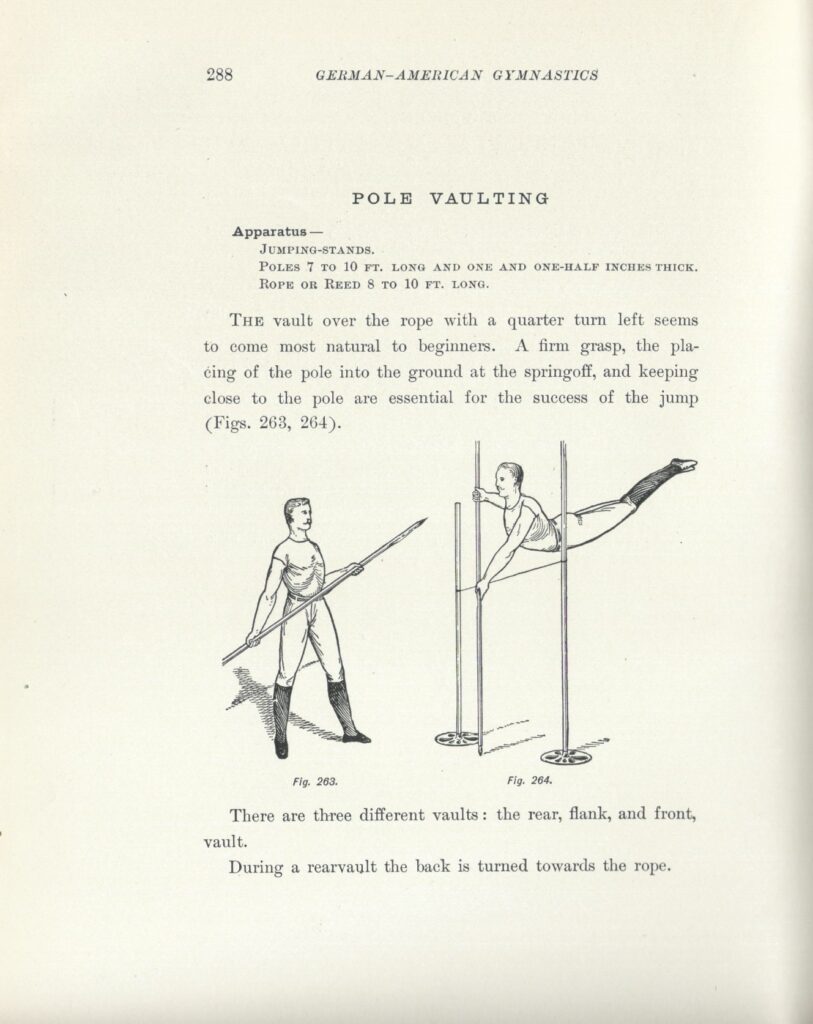
It was also part of the German tradition in 1921:
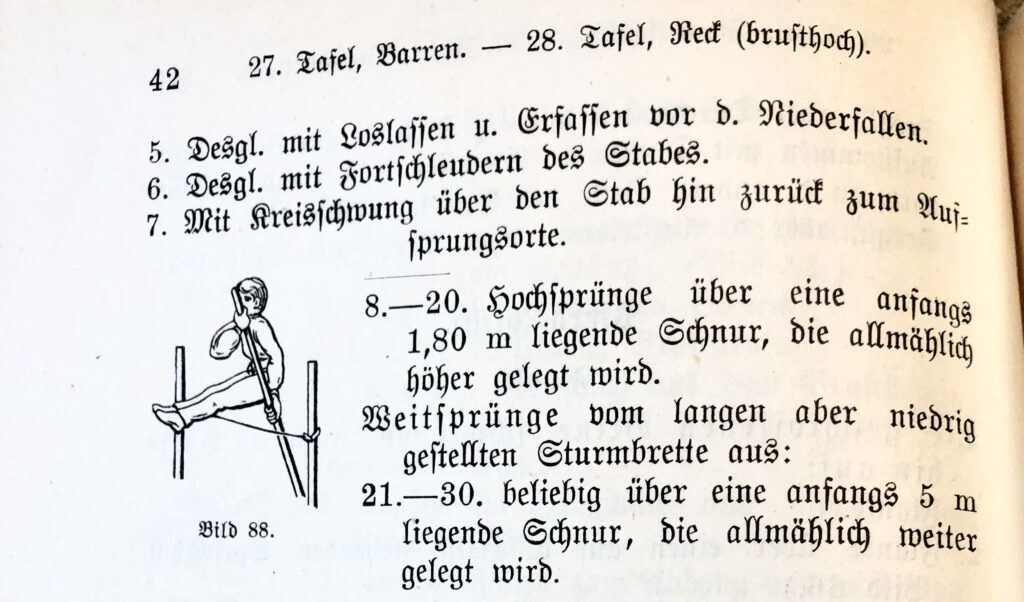
The German/Jahnian influence spread far and wide. As we saw at the French Federal Festival of 1889, track and field was also part of the French gymnastics tradition.
And it continued to be part of the French tradition for many years. For example, in its 1955 women’s program, the French Gymnastics Federation included track and field events like a 60 m sprint and high jump.
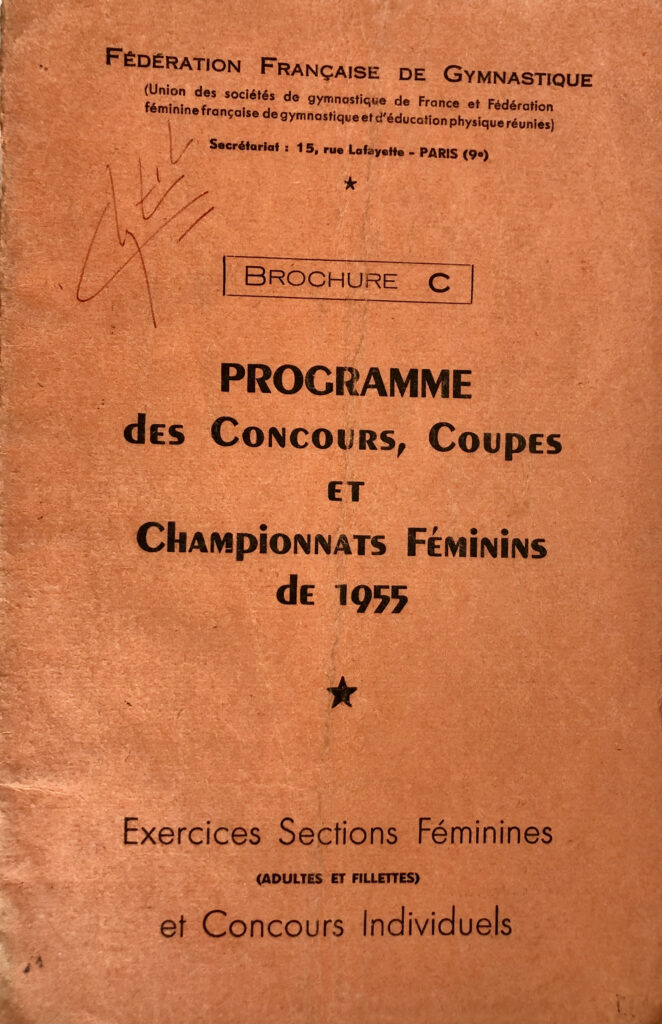
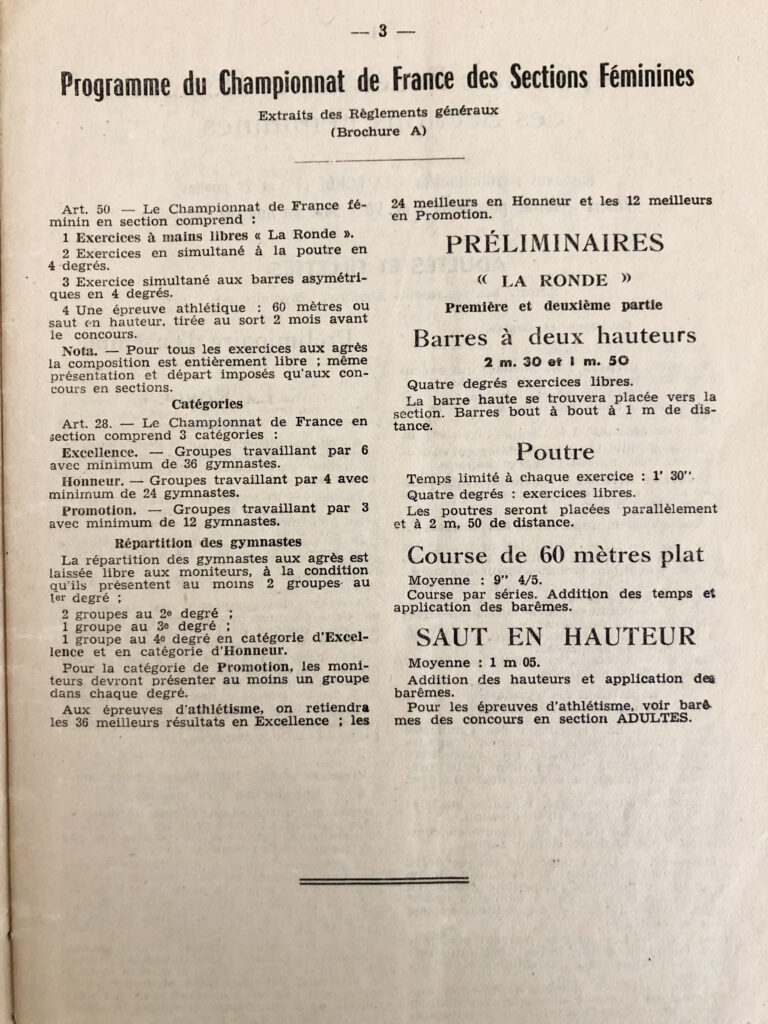
At the Olympic level, the women never competed in track and field events. However, they did compete in athletics at the World Championships.
You can read more about that in this post.
One reply on “1896-1950: The Events of Men’s Gymnastics”
I want to see men’s beam!